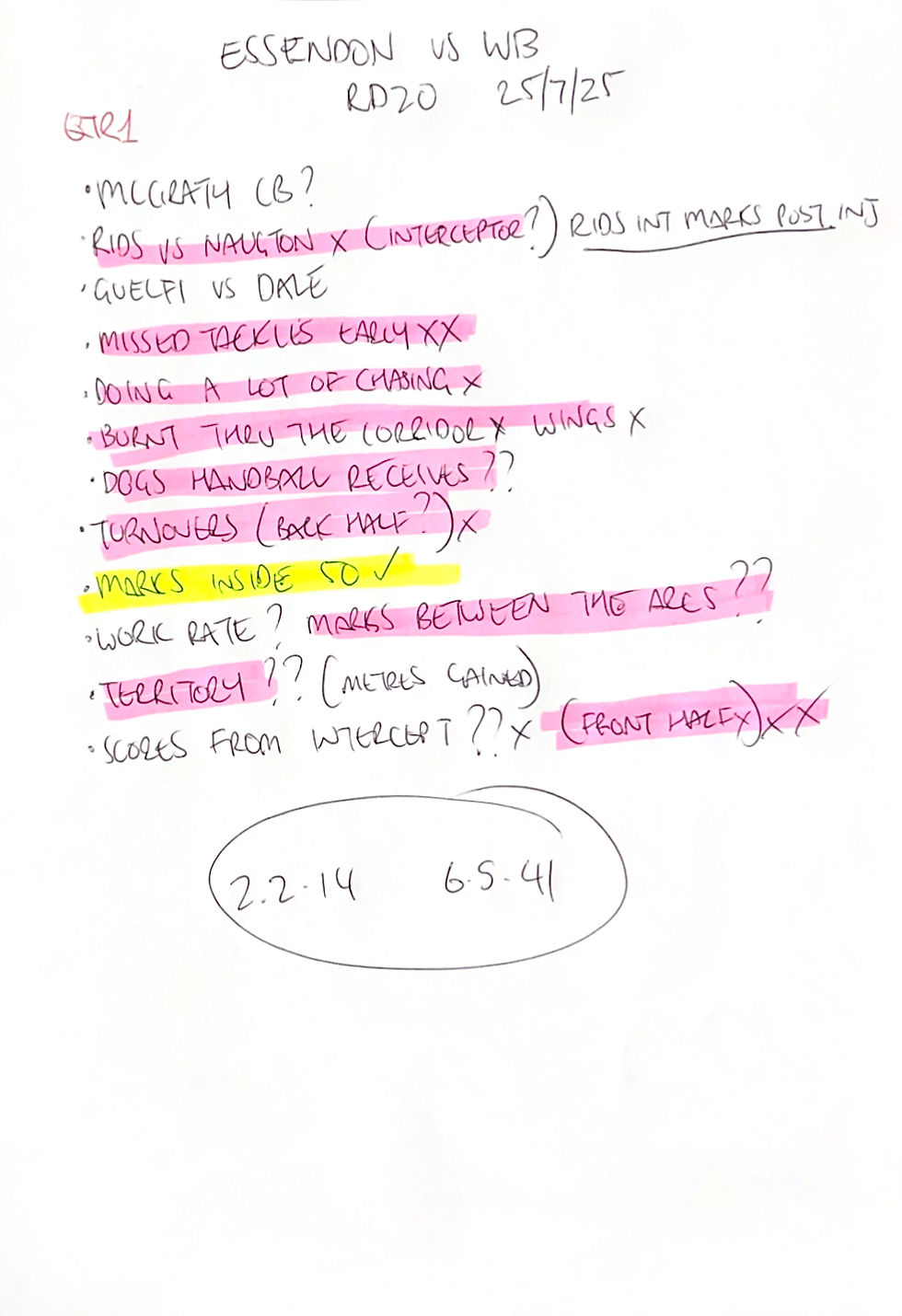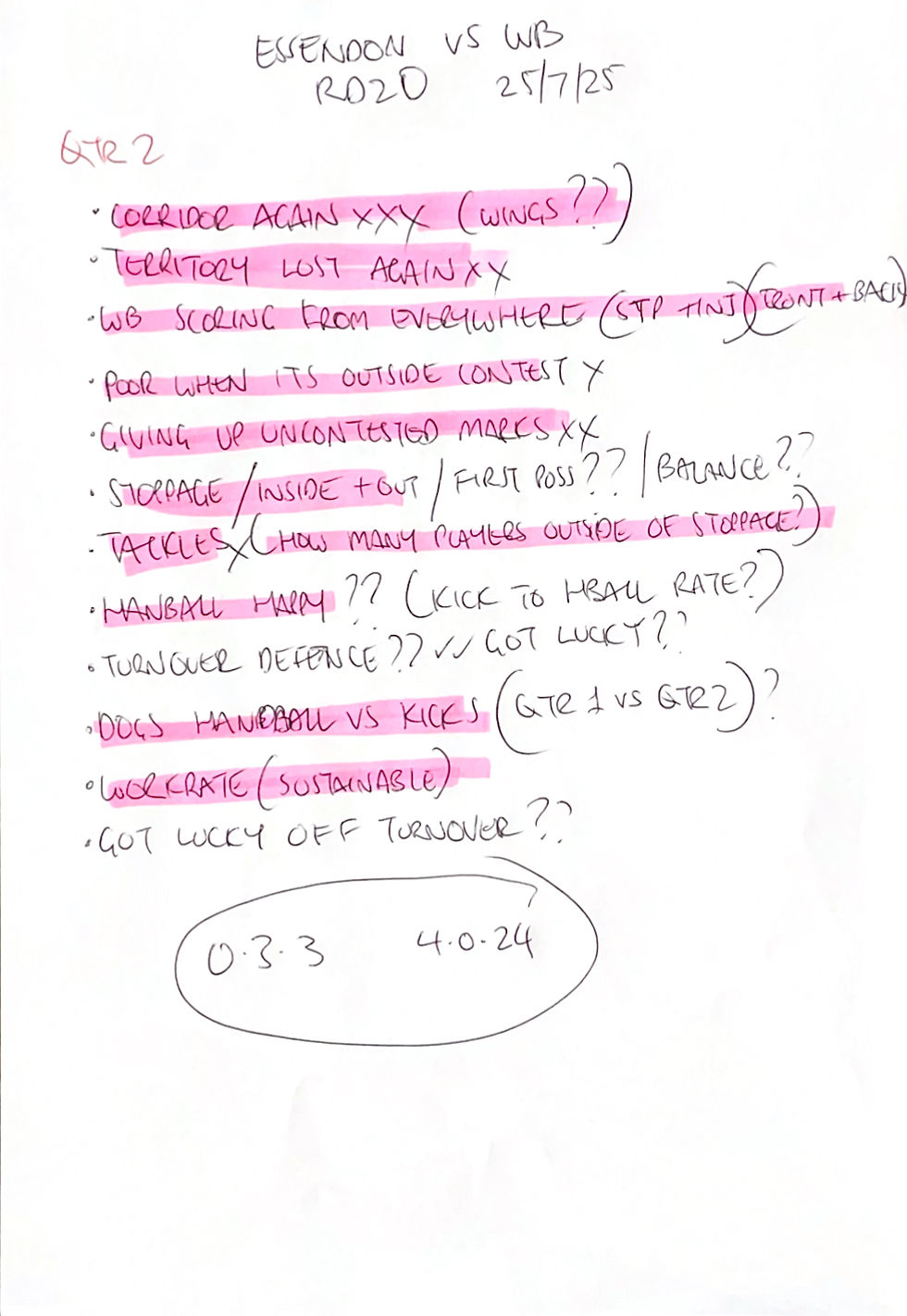
Bombers vs Bulldogs Review
- thebombersblog

- Jul 27
- 9 min read
History.
For the third time this year, Essendon has copped a 90+ point belting, the first time in the club’s history. Two of those have come at the hands of the Western Bulldogs, making it the first time since 2013 that a side has lost by 90 or more to the same team twice in a season.
Back then it was Melbourne, a club still eight years away from achieving the ultimate success. After this season, eight years feels like a reasonable timeline for Essendon to even think about challenging.
My notes.
My reviews always come straight from the notes I take throughout the game, capturing key moments, shifts in momentum, and the positives and negatives as they happen in real time.
For this one, I’ll take you through those notes quarter by quarter, explaining what most observations indicate about how the game unfolded and what they reflect about the performance.
Where possible, I’ll support these points with data to provide a clearer picture of what the numbers say with the action.

Quarter One.
• McGrath in at centre bounce.
In 2021, McGrath attended over 46% of Essendon’s centre bounces, the fifth most among Bombers midfielders that year and the highest share of his nine-year career. The following season, that dropped to just over 23%, and in the first two years under Brad Scott, he didn’t start at a single one.
That changed in Round 2 this year against Adelaide, where he was thrown in for a solitary bounce. Then last week against GWS, he became part of the second-half midfield rotation, starting in the centre square 10 times.
So seeing him used in that role again this week wasn’t exactly a shock. especially after Scott admitted in his post-game presser it was because of lack of choice. The more surprising part was who didn’t get time in the middle, particularly given how things played out last week… but I’ll get to that.
• Ridley to Naughton.
Interesting choice. Not one I would’ve made, mainly due to what it does to the overall system.
Blakiston always looked the likely matchup for Darcy, and I’d have expected Laverde to get the first crack at Naughton. The biggest reason? It frees Ridley up to play to his biggest strength, his ability to intercept in the air, something Essendon has sorely missed during his injury layoff.
Between Rounds 9 and 16, while Ridley was out, Essendon averaged just 12.4 intercept marks per game. well below the AFL average of 15.1, and managed one every 18.75 opposition kicks, the worst rate in the league during that stretch.
With no return in sight for the club’s top two intercept markers this year, McKay and Reid, getting Ridley back as a “free” defender has been a massive boost. His ability to read the ball in flight has brought some much-needed order to a defence that’s been heavily undermanned and under constant attack.
Since his return, he’s averaged 4.3 intercept marks per game, with the team as a whole averaging 18 intercepts at a much better rate of one every 12.1 opposition kicks.
Having Ridley free to control the air would’ve at least asked a few questions in the Bulldogs’ coaches box about their own forward structure.
Oh well, he only lasted a quarter and a half anyway.
• Guelfi to Dale.
This was the matchup I would’ve put my money on, but I had a different option in mind, one that was more about the future.
Quote taken from my preview.
“I see this week as a learning opportunity for a young, inexperienced Essendon lineup, one where the benefits might not be obvious right away, but will become clearer over time. Just like my earlier suggestion of learning positioning and work rate against Richards, I think a similar concept applies with Bailey Dale. And for this, I’ve got a matchup in mind that might seem a little unconventional.
Looking ahead, I see Angus Clarke developing into a rebounding defender who can use his kicking, leg speed, endurance, and intent to take the game on as key assets in Essendon’s ball movement. And while it might seem unusual to place him in the front half this week, this as the perfect chance to “get the pen and paper out” and learn from a player who’s mastered his role.
Timing your movement is critical as a rebounder, and it all starts with positioning. This is a free lesson for the 18-year-old, and it comes with the added benefit of potentially limiting Dale’s impact with ball in hand, which would be a big help to his teammates.”
• Cannot defend the corridor going the other way.
The Bulldogs were allowed too much space through the middle in transition, as the Essendon wingers were being dictated to by having to man up the “fat side” Dogs winger. It dragged them wide and left them unable to fill the most important part of the ground. It would’ve been a better option to just give up the fat side, which was at least two kicks away, compared to just the one needed to switch into the corridor.
• Bulldog handball receives, again.
In their last meeting, the Bulldogs were able to link up by hand and find uncontested options to create run and overlap, finishing with 213 handball receives, the most Essendon has given up all year. It threatened to be a similar story early, with the Dogs racking up over 40 in the opening 20 minutes.
• Dogs set up and forward press is hard to penetrate, not helped by turnovers in the back half.
Some poor turnovers, through foot skills and decision making by both foot and hand, when trying to either reset the field or generate speed from the back half, were being punished on the scoreboard.
From 18 intercept possessions, the Bulldogs generated eight shots at goal, six of them in their own forward half.
• Essendon able to score on transition.
When the Bombers have been able to chain from the back half, including from defensive 50, it’s entering the front third and leading to a shot at goal. Three of their four shots have come from that zone, including one from a kick-in.
Considering the Bulldogs came in as the third-hardest side to move end-to-end against, it’s at least a positive sign once Essendon is able to break through.
• Getting the ball inside 50 and finding marks in there.
Quote taken from my preview.
“The Dogs have allowed 12 marks inside 50 per game to this point —the seventh most in the competition —and they concede them at the fifth-highest rate per entry. Of the sides who allow fewer entries than the Dogs, only Melbourne gives up a mark at a worse rate.”
Eight inside 50s for the quarter isn’t going to challenge the Bulldogs’ defence, but when Essendon has gone in there, they’ve found a marking target on three occasions.
More opportunities would be a start, and more forwards leading at the kicker instead of pointing to the air would absolutely help.

Quarter Two.
• Giving up territory too easily.
Despite winning centre clearances and going forward, any advantage in initial field position was wasted as the Bulldogs transitioned far too easily, with no wing support in the corridor, and now also with the added issue of not defending uncontested marks.
The Dogs only took 17 uncontested marks in the first quarter, at a rate of one every 5.64 disposals, as it was their handball game getting the ball moving. In the second term, it was their foot skills, not needing to be overly precise, as they took 37 uncontested marks, this time at a rate of one every 2.7 disposals.
This is the fourth-most uncontested marks Essendon has allowed in a quarter this year (43 against Brisbane in Q2, 41 against Geelong in Q1, and 40 against Port Adelaide in Q2).
When the Bulldogs have taken 99 or more in a game this year, they’ve won all four, by an average of 78.2 points.
Fifty-four in a half of football isn’t a good sign.
• Essendon has gone handball happy.
Complete opposite of the Bulldogs’ method.
The new style I’ve written about on multiple occasions went to an extreme in the second quarter. 96 disposals, 54 of them handballs, and just 42 kicks.
No team averages a higher percentage of handballs per game than Essendon’s 45.09% (Gold Coast second at 44.42%, North Melbourne third at 43.7%). Since round 12 against Brisbane, that number has climbed even further to 45.98%.
With this comes an inability to find uncontested marks, especially in the back two thirds (only 15 for the quarter). It is forcing Essendon to do a lot of running to support, far too early to be doing that much work and very likely to run out of steam come the second half.
• Getting smashed at stoppages around the ground.
Poor balance, especially around the perimeter, allowed the Bulldogs to take the ball from inside to out and control ball movement.
Thankfully only one shot at goal came from their 11 clearances (one other came from centre bounce).
Essendon not being able to lay a glove on them at restarts or once the ball was in motion didn’t help.
Essendon’s biggest asset this year has been their contest work. In the second 20 minutes, they managed just nine tackles, six in the back two thirds, with 15 players failing, or maybe I should say unwilling, to lay even one.
• Defended turnovers much better.
Will admit they got lucky at times with the Dogs missing some obvious and easy targets, but only two shots at goal from turnover for the quarter is an improvement. Unfortunately, both came from the defensive half, helped by those uncontested marks I wrote about earlier.

Quarter Three.
• Handball happy continues.
After 12 more handballs than kicks in the second quarter, Essendon kept at it, still trying to run at the Bulldogs. Another 46 handballs in the third term to just 33 kicks, and only seven uncontested marks, the fewest they’ve taken in any quarter this season. It wasn’t, and isn’t, sustainable. Especially not when the Dogs continue to play the opposite way.
They found a marking target in space 34 times, once every 3.14 disposals. Essendon? Once every 11.2. One team’s doing it much harder than the other.
The Bulldogs had 39 more uncontested than contested possessions, while Essendon could only manage four — and with all that extra work, it’s starting to take its toll.
• Only scoring from stoppage.
One of the by-products of this game style is the lack of punishment that can reliably come from intercept. The Bombers are always in motion with ball in hand, then forced to work back the other way to defend open space without it, and with fatigue inevitable, stoppage becomes the only real source of score. Both goals for the quarter came this way, one from a centre bounce.
The other effect is what happens when the ball turns over. From just 13 inside 50s, the Bulldogs found five marks inside the area and generated nine shots at goal, six from intercepts, five of those in the front half.

Quarter Four.
Kick to mark rate.
Because of the amount of run and work Essendon had done up to this point, both with and without the ball, the style had to shift back to a more familiar kick-mark game, as the run simply couldn’t continue. The 56 uncontested possessions helped.
18 marks for the quarter, and the kicking looked to go forward to take territory rather than sideways, but that’s understandable given what the first three quarters had taken out of them.
• Centre bounce attendances for Perkins and Gresham?
Last week against the Giants, Perkins and Gresham effectively switched as midfielders in game.
In the first half, Perkins spent most of his time as a mid, starting in the centre square on eight occasions, while Gresham attended none. Then they swapped after half time, Perkins went forward, and Gresham started at the centre bounce nine times.
Now I’ll admit I was a little surprised by that decision, but I can understand that the rotations are becoming fewer and fewer.
Perkins wasn’t a success at all in the role, spending time alongside others on a rampaging Green who had nine clearances in the first half. Perkins managed just one. Gresham, in only a half of football, led the Bombers on the night for clearances with nine, four of those from centre bounce.
That was unexpected last week. But what was more was that Gresham didn’t go on-ball at all this week. Only four midfielders, Merrett, McGrath, Durham and Shiel, were used in 33 centre bounces, the least of any Essendon game this year.
Asking a player to “fill in,” then that player rising to the occasion and ultimately “finding some form,” only to not be given the opportunity to continue the next week — I find that extremely strange. Way to play a player “out of form.”

Conclusion.
Video taken from Brent Stanton’s pre game interview on Fox Footy.
I commend the coaches and players for the attitude, wanting to play a style that continually challenges the opposition, with the view to learning and building that way into the future. But the method currently being practiced in recent games, and the one used in this game, in my view isn’t the right one.
No team can sustain this across four quarters, and none would want to across a full season. It just won’t hold up.
In the middle quarters this week, Essendon had 75 kicks and 100 handballs, with only 28 marks to help, 24 of those uncontested.
The longer it goes on, the more work the players have to do. And that’s before you consider what has to happen defensively without the ball.
I don’t genuinely believe this is the preferred method. The answer has to be somewhere between the kick-mark game of recent seasons and this handball-heavy style.






Comments